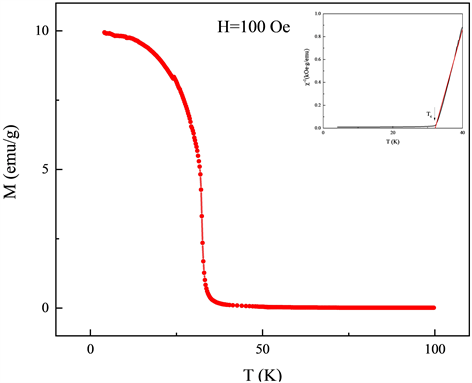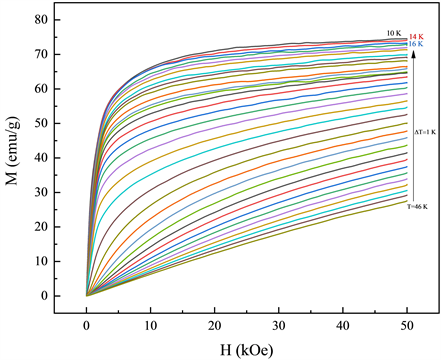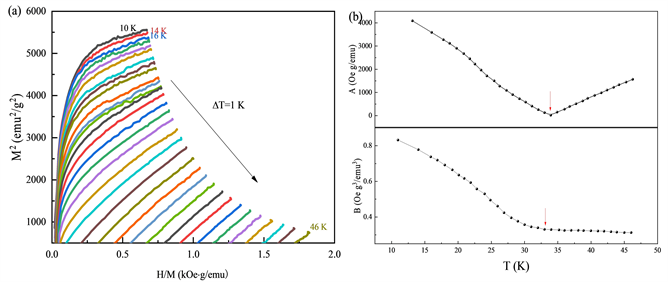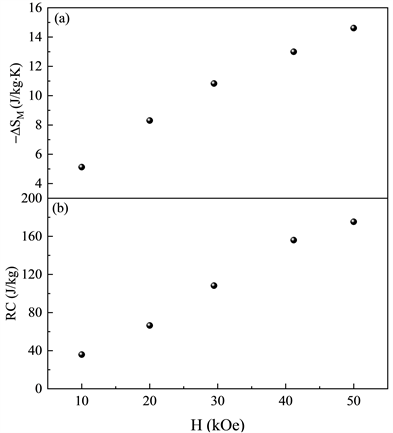1. 引言
磁制冷是一种基于磁热效应的创新高效清洁装置新技术 [1] 。这种系统的最大优点是提高了设备效率,减少了二氧化碳的产生,节省了能源,并且使用一种固体的、不挥发的制冷剂,可以取代温室气体制冷剂 [2] 。因此,寻找具有巨大磁热效应特性的新型材料对科技进一步发展具有重要的意义。室温下稀土二铝化物以MgCu2型立方Laves相晶体结构结晶,过去的几十年,对RAl2 (R = 稀土)金属化合物的磁性性质经过了实验和理论的广泛研究 [3] - [8] ,已经观察到十分有意义的磁性行为,并且这类化合物具有巨大的磁热效应 [2] [9] [10] ,因此在磁制冷方面有着广泛的应用前景,有望成为新一代的智能材料。众所周知,与一级相变相比,二级相变具有宽温区、低滞后等优点,因此二级相变材料是较为理想的制冷材料 [11] [12] [13] [14] 。之前对RAl2化合物的研究表明,PrAl2在居里温度以下会经历立方到四方的晶格畸变 [15] 。因此在本文中,我们对PrAl2化合物进行了磁性测量,来研究化合物的相变类型以及磁熵变。
2. 实验方法
多晶PrAl2合金是在氩气气氛中通过电弧熔化适当的组成金属而成。Pr成分纯度为99.9%,Al的纯度为99.99%,由于稀土元素Pr在熔炼过程中易挥发,因此在配料过程中将Pr过量5%以补偿熔炼过程中所造成的损失。将原料放置在氩气氛围的电弧熔炼炉中,为保证材料成分均匀,将样品反复熔炼3次以上。然后将熔炼后的锭子用钽箔包裹封闭在石英管中,在温度900℃下退火24小时。将退火后的样品利用综合物性测量系统(PPMS)来测量100 Oe外磁场下样品磁化强度(M)和温度(T)之间的关系。随后测量降温过程中样品在零场冷(ZFC)模式下的一系列等温磁化曲线,测量的温度区间在10~46 K,磁场范围在0~5 T。
3. 结果与讨论
图1给出了PrAl2化合物在100 Oe外加磁场下的磁化强度随温度变化的曲线,根据Curie-Weiss定律,在顺磁状态,化合物的磁化率满足χ = C/(T − Tc),其中C为居里常数,Tc为居里温度。由此可以得到PrAl2化合物的顺磁态到铁磁态转变温度为33 K。
图2是PrAl2化合物不同温度下的等温磁化曲线,温度变化范围在10~46 K,其中在16~46 K温度范围内,温度间隔为1 K。从图中知道,在同一温度下,随着磁场的增加磁化强度不断增大。通过等温磁化曲线,计算得到了化合物的Arrot曲线,结果如图3(a)所示。根据Banerjee判据,可以通过Arrot曲线的斜率来判断相变的类型:一级相变中曲线的斜率为负值;二级相变的曲线斜率为正值 [16] [17] 。从图中可以知道Arrot曲线的斜率皆为正值,也就表明PrAl2化合物相变类型为二级相变。
根据Landau理论,材料的Gibbs自由能可以表示为:
(1)

Figure 1. The temperature dependent DC magnetization of PrAl2 under an external magnetic field of 100 Oe. The illustration shows the curve of the compound’s reverse magnetization with temperature, where the red line represents the result of linear fitting of the high-temperature part
图1. 在100 Oe外磁场下的PrAl2化合物的温度依赖性直流磁化强度,插图表示化合物的反转磁化率随温度变化的曲线,其中红线为对高温部分进行线性拟合的结果

Figure 2. Isothermal magnetization curve of PrAl2 compound
图2. PrAl2化合物的等温磁化曲线
其中A(T)、B(T)和C(T)分别是与温度有关的系数。为了维持体系能量最小,即
,可以得到:
(2)
因此A(T)、B(T)和C(T)可以通过H和M的多项式拟合来获得,其计算结果如图3(b)所示。根据Inous-Shimizu模型,A(T)为材料的反转磁化率,并且在居里温度时为最小值;B(T)决定材料的相变类型,在居里温度时,如果B(T)为负值则为一级相变,如果为非负值则为二级相变 [18] [19] [20] 。从图3(b)可以知道,在居里温度处,B(T)为正,表明PrAl2的相变为二级相变。

Figure 3. (a) Arrot curve of PrAl2 compound, (b) The fitted parameter A(T) and B(T) as a function of temperature of PrAl2 compound
图3. (a) PrAl2化合物的Arrot曲线,(b) PrAl2化合物的A(T)和B(T)随温度的变化关系
PrAl2化合物的磁熵变(∆S)作为温度和磁场的函数可以通过使用麦克斯韦关系从等温磁化曲线计算得到:
(3)
在本文中我们主要利用分离磁场下温度与磁化强度的关系曲线来计算磁熵变,所以∆S可以近似由以下方程得到 [21] :
(4)
根据等温磁化曲线和关系式(3)可以得到不同外加磁场下−∆S随温度变化的曲线,如图4所示。从图中可以得到,在50 kOe的磁场下,PrAl2的熵变值达到最大,为14.61 J/kg∙K。
除磁熵变以外,制冷能力(RC)也是磁热效应中的重要性质。制冷能力(RC)为:
(5)
式中Thot和Tcold分别是∆S = ∆SM/2时的温度。∆SM和RC随磁场的变化关系如图5所示,由图可以知道在50 kOe时,RC值达到最大,为175.33 J/kg,由此可以知道PrAl2作为磁性制冷剂有着潜在的应用前景。

Figure 4. Temperature dependent changes in magnetic entropy of PrAl2 compounds at different magnetic fields
图4. PrAl2化合物在不同外加磁场下的磁熵变随温度的变化

Figure 5. (a) The relationship between maximum magnetic entropy change (−∆SM) and (b) refrigeration capcity (RC) of PrAl2 compound and magnetic field
图5. PrAl2化合物的(a) 最大磁熵变(−∆SM)和(b) 制冷能力(RC)与磁场的关系
4. 结论
本文通过电弧熔炼和真空退火的方法制备了PrAl2合金,测量了合金的直流磁化强度和等温磁化曲线,并由磁化曲线得到了Arrot曲线。根据曲线的斜率得到了PrAl2合金的形变类型为二级相变。通过等温磁化曲线计算得到的磁熵变,在50 kOe磁场下达到最大为14.61 J/kg∙K,此时的制冷能力为175.33 J/kg,表明了PrAl2合金具有潜在的应用前景。
基金项目
本研究受到了国家自然科学基金No.11475086项目的资助。